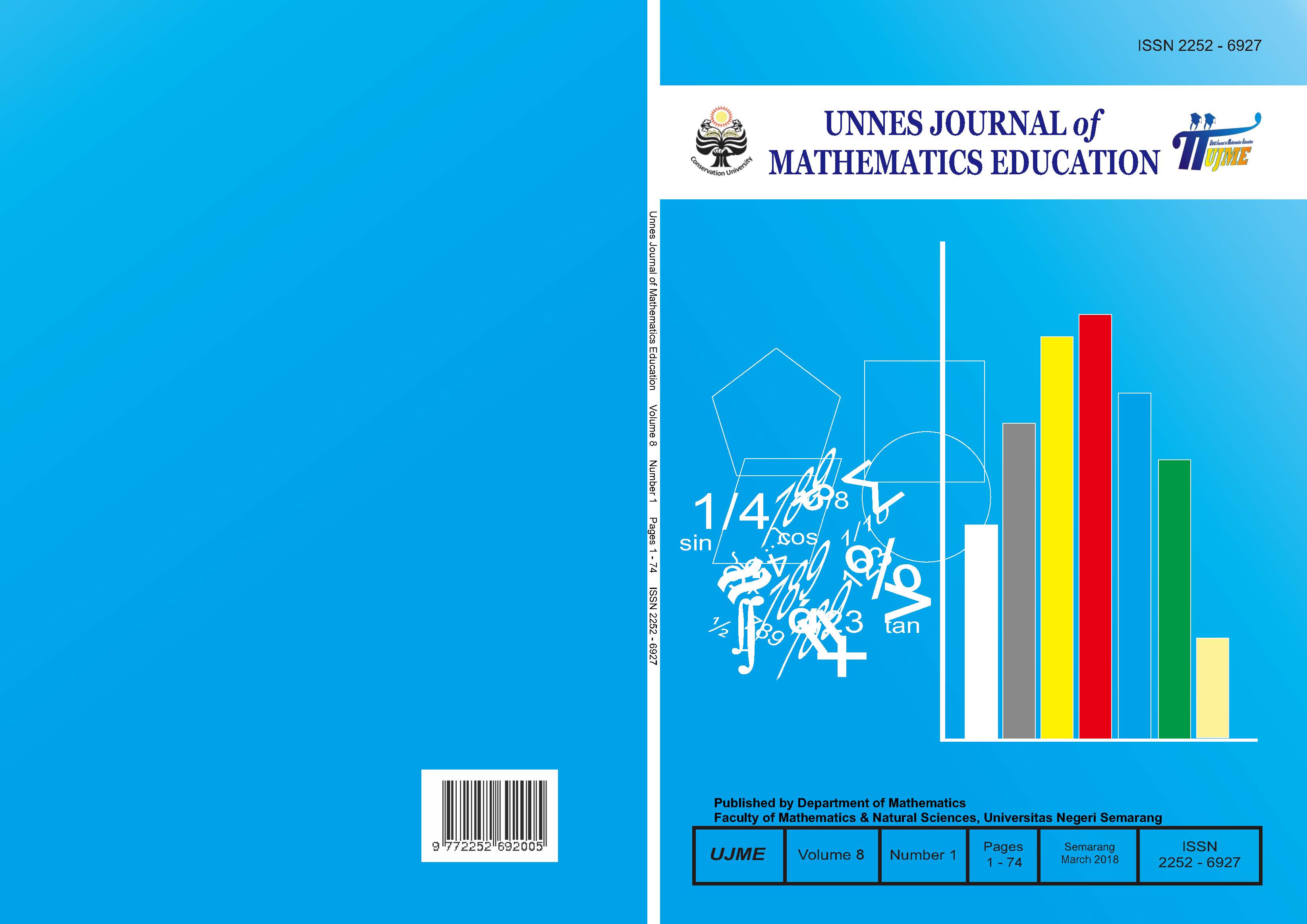Students’ problem solving ability in thinking aloud pair problem solving learning assisted by schoology viewed from mathematical disposition
##plugins.themes.academic_pro.article.main##
Abstract
This research aimed to determine whether Thinking Aloud Pair Problem Solving learning assisted by Schoology was effective to problem solving ability. The method of this research was quantitative-assisted interviews. This research involved 63 selected students of 252 of 8th grade students in one of junior high schools in Kudus. The results showed that: (1) students' problem solving ability in Thinking Aloud Pair Problem Solving learning assisted by Schoology achieved the mastery learning; (2) students’ problem solving ability who received Thinking Aloud Pair Problem Solving learning assisted by Schoology was better than students who received Problem Based Learning; and (3) mathematical disposition possitively affected to the students’ problem solving ability.
##plugins.themes.academic_pro.article.details##
References
George, P. G. 2010. The Effectiveness of Cooperative Learning Strategies in Multicultural University Classroom. Journal on Excellence in College Teaching, 5(1): 21-30.
Irham, M., & Mulyono, M. (2017). Efektivitas Pembelajaran Think Aloud Pair Problem Solving Ditinjau dari Kemampuan Pemecahan Masalah. PRISMA, Prosiding Seminar Nasional Matematika, 356-367.
Kani, N. 2015. Applying the Thinking Aloud Pair Problem Solving Strategy in Mathematics Lessons. Asian Journal of Management Sciences & Education, 4(2): 20-28.
Kilpatrick, J., Swafford, J., & Findell, B. 2001. Adding it up: Helping children learn mathematics (National Research Council. Mathematics Learning Research Committee). Tersedia di https://www.ru.ac.za/media/-rhodes-university/content/sanc/documents/Kilpatrick,%20Swafford,%20Findell%20-%202001%20-%20Adding%20It%20Up%20Helping%20Children%20Learn%20Mathematics.pdf [Accessed on 22-01-2018].
Marisa, R. 2011. Pembelajaran Matematika dengan Pendekatan Realistik Untuk Meningkatkan Kemampuan Pemecahan Masalah dan Disposisi Matematis Siswa. Thesis. Bandung: Universitas Pendidikan Indonesia.
Masrukan. 2008. Kemampuan Pemecahan Masalah dan Komunikasi Matematika. Pengaruh Penggunaan Model Pembelajaran dan Asesmen Kinerja Terhadap Kemampuan Pemecahan Masalah dan Komunikasi Matematika (Eksperimen Pada Siswa Kelas VIII SMPN 10 Dan SMPN 13 Kota Semarang). Disertasi. Semarang: Unnes.
NCTM. 2000. Principles and Standards for School Mathematics. Reston, VA: NCTM.
Nurhasanah, R.A., Winarti, E.R. & Hendikawati, P. 2017. Analisis Komunikasi Matematis Pada Pembelajaran GeometriMenggunakan Model PBL dan TTW Ditinjau dari Self Efficacy Berbantuan Schoology. Unnes Journal of MathematicsEducation, 6(3): 1-9.
Peraturan Pemerintah Nomor 17 Tahun 2010 Pasal 48 Tentang Pengelolaan dan Penyelenggaraan Pendidikan.
Peraturan Pemerintah Nomor 17 Tahun 2010 Pasal 59 Tentang Pengelolaan dan Penyelenggaraan Pendidikan.
Polya, G. 1973. How to Solve It. New Jersey: Princeton University Press.
Rahayu, R., & Kartono. 2014. The Effect of Mathematical Disposition toward Problem Solving Ability Based On IDEAL Problem Solver. International Journal of Science and Research, 10(3): 1315-1318.
Tambychik, T., & Meerah, T. S. M. 2010. Students’ Difficulties in Mathematics Problem-Solving: What do they Say?. Procedia-Social and Behavioral Sciences, 8: 142-151.
Wardlow, G. W., & Johnson, D. M. 2004. Effects Of Thinking Aloud Pair Problem Solving On The Troubleshooting Performance Of Undergraduate Agriculture Students In A Power Technology Course. Journal of agricultural education, 45(4): 1-11.
Wijayanto, Z. 2014. Eksperimentasi Model Pembelajaran Kooperatif Tipe Think Pair Share (TPS) Dengan Pendekatan Open-Ended Ditinjau dari Disposisi Matematis Siswa Kelas VIII SMP Negeri di Kabupaten Purworejo. Jurnal Ilmiah Pendidikan Matematika, 3(2): 427-438.
Woolfolk, A. & Marggarets, K. 2012. Educational Psychology Australian Edition. Australia: Pearson Higher Education.
